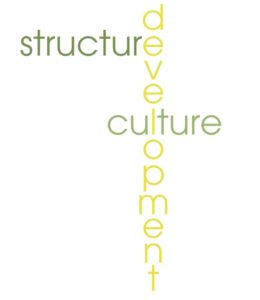If you lead an organization, work in an organization, or even set foot in an organization, you know that we are living in a time of significant structural change. Many forces and factors are contributing to these changes, including:
- The significant proportion and importance of knowledge work – and the unique
 challenges associated with managing it.
challenges associated with managing it. - Escalating customer expectations means that the bar continues to be raised in terms of innovation, quality, and cost.
- Competition comes from all parts of the world and from new (and frequently disruptive) sources.
- Downward pressure on cycle time results in investing extraordinary effort for sometimes incremental improvements.
- Changing workplace demographics offer the most diverse employee population ever, with greater numbers of younger employees who bring different expectations to the job.
- Today’s distributed workforce has people making their contributions to the business from far-flung places, day and night.
In response to these changes and challenges, organizations are morphing. Old structures are no longer delivering the results they once did. (Notice the term we’ve used for decades: ‘structure’. Even the label implies limitations, a controlled & contained quality, and the expectation that everyone will color within the lines.)
As these old structures fall away, they’re giving way to new and evolving approaches to organizing people and work for better results.
| Then | Now |
| Hierarchical | Hyper Responsive
Human |
| Functional | Fungible
Fluid |
| Orderly | Organic
Outwardly-focused |
| Command&Control | Curated
Collaborative Connected |
What used to be rigid and hierarchical is becoming more human and highly responsive to changing business needs. The former focus on functions is evolving to allow for a more fluid exchange of resources as necessary. The orderly structures of the past that reflected an inward-looking orientation are giving rise to outwardly-focused, organic structures. And finally, ‘command and control’ that has characterized business for decades is now being replaced with curated groups and far greater collaboration.
But new organizing schemas are just the first step. They are the physical manifestation of change. But what they can accomplish is highly dependent upon the culture and norms within the organization. New structures quickly disintegrate if culture doesn’t align behind them.
Blurry Vision is the New 20/20
One of the most fundamental cultural shifts required to support the evolving way people are organized and working today is from clear lines of demarcation among and between departments, division, and functions to an environment that consciously cultivates and celebrates blurry boundaries.
Yet, at a time when ‘clarity’ is among the most sought-after and talked-about quality in organizations, how can we justify blurring the boundaries and potentially introducing confusion within an organization?
Take a moment to consider this. To what extent:
- Does collaboration among groups, teams, departments, and/or divisions naturally flourish?
- Is ‘us’ and ‘them’ part of the lexicon or people’s thinking?
- Are resources frequently and generously shared across departments to accomplish goals?
- Are employees encouraged to look outside of their own areas for opportunities to learn, contribute, and grow?
Blurry boundaries are not about confusion or lack of clarity… quite the opposite. When we trade the hard lines and artificial borders that we’ve constructed between departments or divisions, our vision improves, illuminating opportunities to collaborate. When we stop thinking in terms of ‘us’ and ‘them’, we can appreciate and leverage our interconnectedness. When we step out of our traditional boxes and into the broader organizational milieu, we can see, and be part of, the bigger picture. Blurring the boundaries in this way involves a mindset that’s more generous and inclusive – and one that’s focused more broadly on the enterprise as a whole.
Development is at the Center of it All
Successfully transitioning to structures that better address the challenges facing business today is inextricably connected with the role of talent and career development. But what exactly is the relationship? Is development a contributor to or outcome of these structural changes?
Yes, to both! Making the most of the evolving, more organic and fluid structures demands new skills. Collaboration. Listening. Feedback. And that’s just the beginning. Operating effectively without the traditional hierarchical order puts more onus on each employee to step up in different ways, making learning and development non-negotiable.
But these structures tend to enable greater development as well. Leaders who have figured out how to blur boundaries find themselves supporting development in more and different ways. They know how to look more broadly and outside of their own areas for opportunities. Structures might enable it – but it’s a leader’s willingness to move people around and even lose good talent to their colleagues that drives employee development and organizational results.
Blurring the boundaries is good for evolving organizational structures. It’s good for talent and career development. It’s good for your people. And it’s good for the business. So, start by taking a few small steps like:
- Getting to know your colleagues in other parts of the business.
- Finding ways to support the efforts of those outside of your own group.
- Interrupting competition and territorialism before it takes hold.
- Seeking out collaborations with colleagues that offer developmental experiences for your employees.
Blurring boundaries just might be the clearest way to support the culture, structures and development that organizations need and employees want!
Originally published on SeapointCenter.com.


